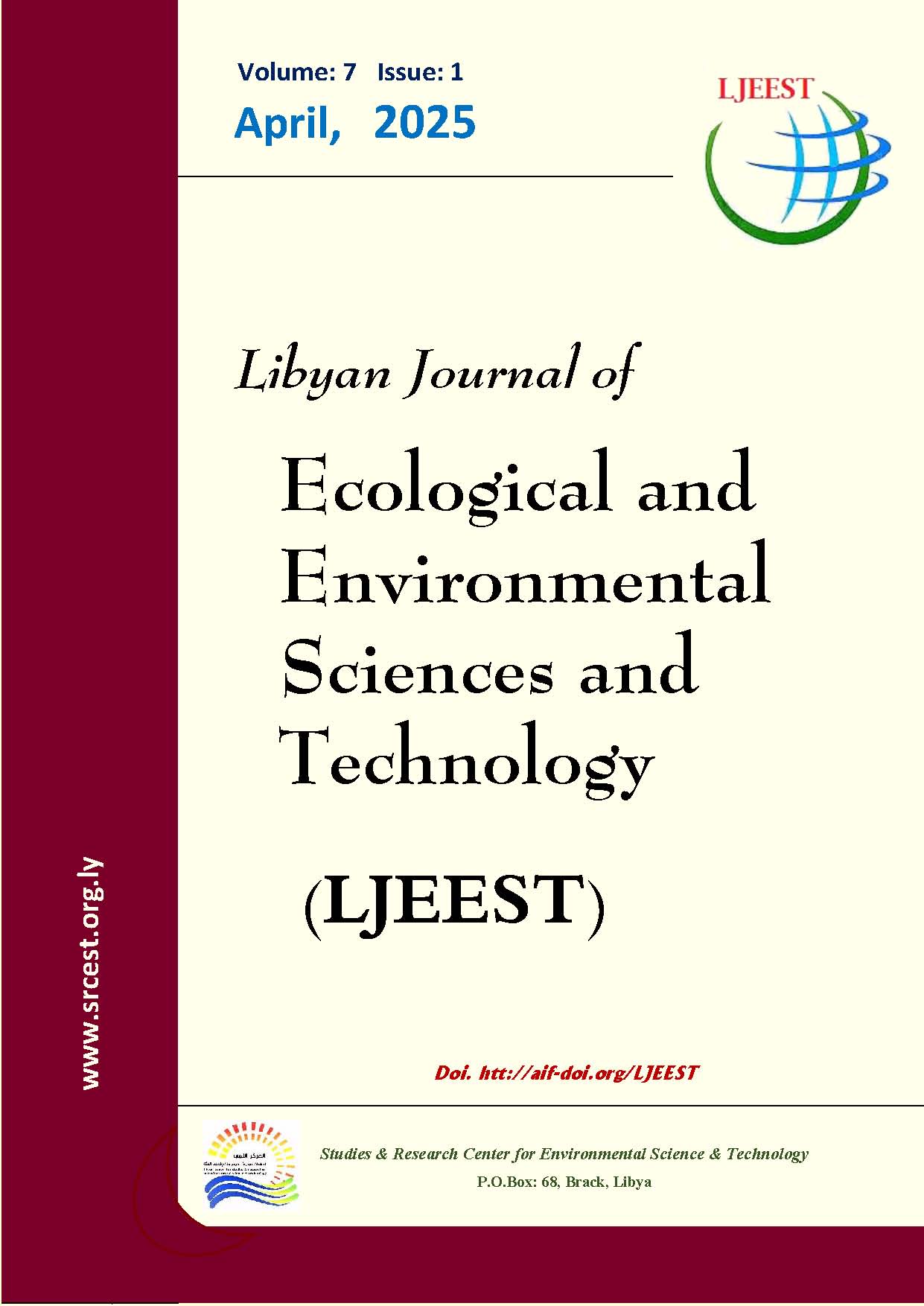Size Structure and Dynamics of Thymus Capitatus in Different Habitats in Southern Al-Jabal Al-Akhdar, Libya
DOI:
https://doi.org/10.63359/32w22009Keywords:
Thymus plant, Size Structure, Dynamic, southern Al-Jabal Al- Akhdar; Libya.Abstract
The size structure of wild thyme growth in the southern parts of the Al-Jabal Al-Akhdar region, Soil samples were collected from the surface of each site, and were more or less positively correlated with silt, clay, chloride, calcium, fine sand, and carbonate. On the other hand, they were negatively correlated with nitrogen and potassium. The number of individuals of species was counted while the height (H) and mean crown diameter (D) were measured. Generally, the height to diameter ratio was less than unity for Thymus capitatus, this means that the diameter of these species tend to expand horizontally rather than vertically, The size index of each individual was calculated and then used to classify population into 7 size classes: 1 cm size 7 cm .Five forms of size distribution along the different elevations were recognized, it was found that Thymus capitatus exhibited more or less J-shaped distribution and along elevation levels (High and Low).Thymus capitatus exhibited more or less symmetrical distribution (bell-shaped) along the elevation level (Medium). The negative skewed distribution of Thymus capitatus indicated the dominance of mature individuals over the juvenile ones.
References
Abdel Wahab, R., Zaghloul, M., Kamel, W. & Abdel Raouf, A. (2008). Diversity and distribution of medicinal plants in North Sinai, Egypt. African Journal of Environmental Science and Technology; 2 (7):157–171.
Ali, E., Mustafa, H.,&Blkasem, K. (2019).Morphological variation of Libyan carob (CeratoniasiliquaL.).Al-Mukhtar Journal of Sciences, 34(2), 126-133.
Al-Idrissi, M., Sbeita, A., Jebriel, S., Zintani, A., Shreidi, A., Ghawawi, H., &Tazi, M. (1996). Libya: Country report to the FAO international technical conference on plant genetic resources. Leipzig, Germany. FAO
Allen, S., Grimshay, H.,Parkinson, J., & Quarmby, C. (1974).Analysis of Ecology Materials.Oxford, London: Blackwell Scientific Publications, pp: 565.
Blancher, R., Rehm, G., & Caldwell, A. (1965).Sulfur in plant materials by digestion with nitric and perchloric acid.Soil Science Society of America, Proceedings, 29:71-72.
Colwell, R. & Lees, D. (2000). The mid-domain effect: Geometric constraints on the geography of species richness. Trends Ecol. Evol., 15: 70-76.
Dong, M. (1987). Population structure and dynamics of Pinusmassoniana Lamb. on mount Jinyun, Sichuan, China. Vegetatio,72:35-44.
El-Tantawi, A. (2005). Climate change in Libya and desertification of Jifara Plain. PhD thesis. University of Johannes Gutenberg. Mainz, Germany.
Ezzudin, S., Ali., Hesaien, M., Mustafa, & Khansa, A., Omaar.(2022). Phylogenetic Analysis of Libyan Thyme (Thymus Capitatus) Inferred from The Morphological Traits. Al-Mukhtar Journal of Sciences 37 (4): 385-393.
Gupta, P. (2000). Soil, plant, water and fertilizer analysis.Agrobios (India), Jodhpur, New Delhi, India, 438.
Hegazy, A., Fahmy, G., Ali, M., &Gomaa, N. (2004).Vegetation diversity in natural and agro-ecosystems of Arid Lands.Journal of Community Ecology; 5: 163–176.
Hobbs, N., Landsberg, J., O’Conner, T., &Freudenberger, D. (1999).Responses of Large Herbivores to Spatial Heterogeneity in Ecosystems, and the Impacts of Livestock Grazing on Biodiversity in Natural Ecosystems” from Nutritional Ecology of Herbivores. Pp. 97-129, 752-777.
Mahmoud,A.,Gadallah,A.,Mohemmed, S., Mohamed, M., Abdel-Ghani, A.,Alhendawi, R.,& Russell.(2008). Aspects of range condition recovery in the southern Jebel Al Akhdar, northeastern Libya.Proceedings of the XXI International Grassland Congress and the VIII International Rangeland Congress,Multifunctional Grasslands in a Changing World Volume (1).
Mabroka A. G.Abdalrhim. (2023). Population structure and dynamics of Seriphidium herba-alba (Asso) Soják in different habitats in Jardas Jerrari, Al-Jabal Al- Akhdar, Libya. Global Libyan journal. 69:2518-5845.
Monks, L., Coates, T.,Bell.,& Bowles, M. (2012).Determining success criteria for reintroductions of threatened long-lived plants. In: (Eds.): Maschinski, J. and K.E. Haskins. Plant reintroduction in a changing climate: Promises and Perils. Island Press, Washington, 189-208.
Mosallam, H. (2005). Size Structure of Zygophyllum album and Cornulacamonacantha Populations in Salhyia Area, East of Egypt.International Journal of Agriculture and Biology. 7:345-351.
Niklas, K., Cobbi, E. & Marler, T. (2006). A comparison between the record height-to-stem diameter allometries of Pachycaulis and Leptocaulis species. Ann. Bot, 97: 79-83.
Shaltout, K., Fawzy, M., Galal, T., Awad, M., El-Barasi, Y.,& Saeed, B. (2015).Impact of waste water discharge on the plant communities and size structure of Wadi El-Shees, Al-Jabal Al-Akhdar, Libya. FeddesRepertorium, 126(1):6–15.
Shaltout, K., Fawzy, M., Galal, T., Awad, M., El-Barasi, Y., & Saeed, B. (2014). Impact of waste water discharge on the plant communities and size structure of Wadi El-Shees, Al-Jabal Al-Akhdar, Libya. Feddes Repertorium, 125, 1–13.
Svensson, J.,&Jeglum, J. (2001). Structure and dynamics of an undisturbed old-growth Norway spruce forest on the rising Bothnian coastline.Forest Ecology and Management, 151: 67-79.
Watson, M.,& Brown, J. (1998).Recommended Chemical Soil Test Procedures for the North Central Region.North Central Regional Research Publication.Missouri Agricultural Experiment Station.North Central Regional Research Publication. No. 221
Downloads
Published
Issue
Section
License
Copyright (c) 2025 Libyan Journal of Ecological & Environmental Sciences and Technology

This work is licensed under a Creative Commons Attribution-NonCommercial 4.0 International License.














